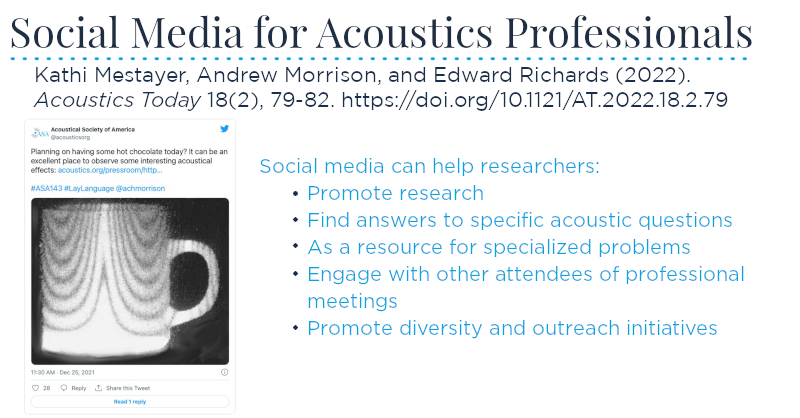ASA Publications Guide to Social Media1
This guide provides tips and templates for promoting your publications on social media.
Getting Started on Social Media
- For your profile/bio: include a real picture of your face, your real name, and affiliation.
- For your background image: choose an image that conveys what you do and your authority/expertise
- Find your audience: search for hashtags related to your field and follow people using these hashtags. Find at least two broad hashtags (like #AcademicTwitter) and two niche ones (like #acoustics or #ITeachPhysics if that’s relevant). See Resources below.
- Comment, like, and share/re-tweet interesting articles and postings. Set aside 20-30 minutes every day to engage with social media.
Sharing Your Research: Templates for Posts
Please note: when you see text within brackets [ ], this indicates that you need to edit according to the instructions. After customizing the text, remove the quotation marks and brackets before posting.
- “Read my article published with @acousticsorg in [@JOURNAL] about [ONE SENTENCE SUMMARY]: [INSERT DOI LINK]”
- “Have you heard? [PAPER’S TITLE] from [JOURNAL NAME] on [#SUBJECT] is available to read [INSERT DOI LINK]”
- “Read my latest #research on [#SUBJECT], published with @acousticsorg in [@JOURNAL]. Read here: [INSERT DOI LINK].”
- Choose one brief sentence from your article that may be attractive to your audience. Include that sentence, then end the post with, “Read more: [INSERT DOI LINK]”
- Come up with an alternative self-explanatory title. This title should be short and directly related to the content. Post, “Read my latest #research on [ALTERNATIVE TITLE], published with @acousticsorg in [@JOURNAL]. Read here: [INSERT DOI LINK]”
- If you’re savvy with image or presentation software, try creating a visual abstract! Include the title, publication info, one or two key takeaways from the article, and an eye-catching visual.
Download a visual abstract Twitter template here.
Download a visual abstract Instagram template here.
Other Tips
- Make sure to always include an image with your posts. Posts with images get noticed significantly more than those that include only text.
- Include relevant hashtags on words in the tweet/post that other people may be following.
- Pin any posts about your latest research on the top of your social media profile, so they’re the first thing your visitors see!
- Avoid jargon where possible. There is a De-Jargonizer program which can give you insights into how common the words you are using are in everyday media.
Expanding Your Reach
- Update your social media bio to include: “Author of [PAPER’S TITLE] in [JOURNAL NAME]. Read here: [INSERT DOI LINK]”
- On posts of news and science articles relevant to your research, share/retweet or reply to the post with a link to your article. It can be helpful to include a little commentary on how your article is related.
- Don’t post about your research only once! Since social media news feeds change constantly, folks may miss your initial post. Make sure to share your research a few times over the month or two following publication.
- Don’t be shy! If you can tie your research into a larger conversation in your field, do so.
And remember, tag the ASA and ASA journals so we can share your posts!:
ASA
Twitter: @acousticsorg
Facebook: @acousticsorg
LinkedIn: The Acoustical Society of America
Instagram: AcousticalSocietyofAmerica
ASA Publications:
Twitter: @ASA_JASA, @ASA_JASAEL, and @ASA_POMA
Facebook: @JournaloftheAcousticalSocietyofAmerica, @JASAExpressLetters, @ASAPOMA
Resources
Webinar on Using Social Media to Promote Your ASA Publications
Twitter User Lists:
Acoustics People
Ultrasound Research (USR)
Linguistics, Music, Psych
Suggested hashtags:
#AcousticalOceanography
#acoustics
#AcousticsEducation
#AcousticsPerception
#ambisonics
#AnimalBioacoustics
#ArchitecturalAcoustics
#binaural
#bioacoustics
#BiomedicalAcoustics
#ComputationalAcoustics
#decibels
#DigitalSignalProcessing
#DSP
#HardofHearing
#HearingLoss
#MusicalAcoustics
#noise
#NoiseControl
#PhysicalAcoustics
#SignalProcessing
#sound
#SoundLocalization
#Soundscapes
#SoundWaves
#SpeechAcoustics
#StructuralAcoustics
#ultrasound
#UnderwaterAcoustics
#vibration
#VirtualAcoustics
[1] Based on the Springer Nature 4-week plan and the Ninja’s Twitter Guide

